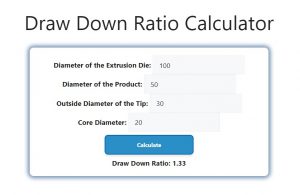About Draw Down Ratio Calculator (Formula)
The Draw Down Ratio (DDR) is an essential metric in various manufacturing processes, particularly in extrusion. It helps evaluate the efficiency and quality of products produced by measuring the relationship between the dimensions of the extrusion die and the final product. Understanding and utilizing the Draw Down Ratio Calculator can significantly enhance production processes, reduce waste, and improve the quality of extruded products. This article will explore the formula used for calculating the draw down ratio, how to use the calculator effectively, and answer common questions related to this critical tool.
Formula
The formula for calculating the Draw Down Ratio is as follows:
DDR = (DD / PD) / (DT / CD)
Where:
- DD is the Diameter of the Extrusion Die
- PD is the Diameter of the Product
- DT is the Outside Diameter of the Tip
- CD is the Core Diameter
How to Use
Using the Draw Down Ratio Calculator is straightforward and involves the following steps:
- Gather Data: Collect the required measurements:
- Diameter of the Extrusion Die (DD)
- Diameter of the Product (PD)
- Outside Diameter of the Tip (DT)
- Core Diameter (CD)
- Input Values: Enter the values into the calculator according to their respective fields.
- Calculate the Ratio: Click the calculate button to determine the Draw Down Ratio (DDR) using the provided formula.
- Interpret Results: Analyze the DDR value to assess the efficiency of your extrusion process. A higher DDR indicates better control over the extrusion process and better product quality.
Example
For instance, let’s say we have the following measurements:
- Diameter of the Extrusion Die (DD): 100 mm
- Diameter of the Product (PD): 50 mm
- Outside Diameter of the Tip (DT): 30 mm
- Core Diameter (CD): 20 mm
Using the formula:
DDR = (100 / 50) / (30 / 20)
DDR = 2 / 1.5
DDR = 1.33
In this example, the Draw Down Ratio is 1.33, indicating a moderate level of efficiency in the extrusion process.

FAQs about the Draw Down Ratio Calculator
- What is the Draw Down Ratio?
The Draw Down Ratio measures the efficiency of the extrusion process by comparing the dimensions of the die and the final product. - Why is the Draw Down Ratio important?
It helps identify how effectively the material is processed, influencing product quality and consistency. - What do the variables DD, PD, DT, and CD represent?
DD is the diameter of the extrusion die, PD is the diameter of the product, DT is the outside diameter of the tip, and CD is the core diameter. - How often should I calculate the Draw Down Ratio?
It’s advisable to calculate it with each new batch or significant change in material to ensure consistent quality. - Can the Draw Down Ratio affect product quality?
Yes, a proper DDR can lead to improved product quality by ensuring optimal material flow. - What does a high Draw Down Ratio indicate?
A high DDR typically suggests that the extrusion process is well-optimized, producing higher quality products. - Can this calculator be used for other manufacturing processes?
While primarily used in extrusion, the concept can be adapted to other processes involving dimensional changes. - What happens if the Draw Down Ratio is too low?
A low DDR may indicate inefficiencies, leading to defects or variations in product dimensions. - Is there a standard Draw Down Ratio to aim for?
There isn’t a universal standard; it varies depending on the material and application, but consistency is key. - Can I use the calculator for different materials?
Yes, the calculator can be used for various materials, but results may vary based on material properties.
Conclusion
The Draw Down Ratio Calculator is an invaluable tool in the extrusion industry, helping manufacturers optimize their processes for better quality products. By understanding how to use the calculator and interpreting its results, businesses can enhance production efficiency, reduce waste, and ensure consistent product quality. Regularly calculating the Draw Down Ratio allows for ongoing adjustments and improvements, ultimately leading to higher customer satisfaction and operational success.
